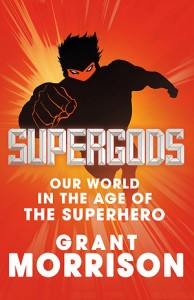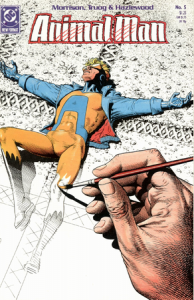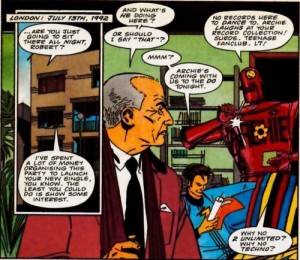Supergods: Our World in the Age of the Superhero
Reviewed by Ed Whatley 06-May-12
Grant Morrison has been a hero for as long as I’ve had heroes, from me and my brother devouring Zenith when it was in 2000 AD, all the way up to reading the first edition of All Star Superman, his greatest work, and the best superhero comic ever written.
 Grant Morrison has been a hero for as long as I’ve had heroes, from me and my brother devouring Zenith when it was in 2000 AD, through having my first heavy meta experience in W.H. Smith’s in Sutton when Wile E Coyote dropped into Animal Man to plead for release, to happy times reading my friend Andy’s Doom Patrols in contented silence in his small Oxford flat, to consuming Morrison’s Olympian Justice League for free under the twin-tailed siren of Starbucks in Borders, hopped up and shaking on mocha, and all the way up to reading the first edition of All Star Superman, his greatest work, and the best superhero comic ever written, on a train from New Jersey to New York, never having felt happier to have spent three bucks on anything.
Grant Morrison has been a hero for as long as I’ve had heroes, from me and my brother devouring Zenith when it was in 2000 AD, through having my first heavy meta experience in W.H. Smith’s in Sutton when Wile E Coyote dropped into Animal Man to plead for release, to happy times reading my friend Andy’s Doom Patrols in contented silence in his small Oxford flat, to consuming Morrison’s Olympian Justice League for free under the twin-tailed siren of Starbucks in Borders, hopped up and shaking on mocha, and all the way up to reading the first edition of All Star Superman, his greatest work, and the best superhero comic ever written, on a train from New Jersey to New York, never having felt happier to have spent three bucks on anything.
This book works as a history of the “ages” of comic books, starting in the Golden Age, where Superman’s success brought forth a whole slew of long-tights musclemen; then the Silver Age, where those characters were reborn after McCarthy in a kaleidoscopic series of waking dreams, psychedelic nightmares and epic leaps into enormity from characters and creators; then the Dark Age, where getting older, enlightenment and embarrassment gave rise to darkness and complexity which in turn became morbidity; then what Morrison calls the “renaissance”, where comics accepted themselves and became an assured mirror for the best and worst of what current society tells us about ourselves, via a whole slew of long-tights musclemen.
 Writing about the state of NOW, Morrison happily evokes how we have all become superheroes, with our online names and identities, our hyper-connected machine-interfaced lives, and our ongoing self-constructed and publicised legends. He also touches on the flipside of that, the angry internet mob, angry anal scumbags in their lairs, lashing out at anyone who doesn’t fit their tiny template of what’s right, and trolling the happiness out of creatives and schoolkids as effectively and unpleasantly as any Joker mind-trap. Morrison doesn’t say it explicitly, but if we are all superheroes through our constructed online selves, trolls are obviously the supervillains. (And just like the flip-flopping storylines where hero becomes villain and villain hero, we are all capable of being either.)
Writing about the state of NOW, Morrison happily evokes how we have all become superheroes, with our online names and identities, our hyper-connected machine-interfaced lives, and our ongoing self-constructed and publicised legends. He also touches on the flipside of that, the angry internet mob, angry anal scumbags in their lairs, lashing out at anyone who doesn’t fit their tiny template of what’s right, and trolling the happiness out of creatives and schoolkids as effectively and unpleasantly as any Joker mind-trap. Morrison doesn’t say it explicitly, but if we are all superheroes through our constructed online selves, trolls are obviously the supervillains. (And just like the flip-flopping storylines where hero becomes villain and villain hero, we are all capable of being either.)
 Having recently read Simon Reynolds’ Retromania, describing how music creators and consumers have moved away from the relentless neophilia of successive new trends of music, and now layer knowing history on knowing history, it was interesting to contrast that with the history of comics. In comics, nostalgia, referencing history and stacking up the past and the present have been fundamental to the form since its second age. Morrison has even been heavily involved in the various mega-event attempts to rationalise and condense the weight of and size of the history of the DC Universe, and he talks in the book about how big, complex and controversial a task this can be. One of the best things about Renaissance era comics is how (some) have happily accepted this billowing history and had fun with it, extending it out to the infinity of fiction (League of Extraordinary Gentlemen) or whacking on new Universes in “reality” full of fantastical echoes (Kingdom Come, Ultimates). Comics fans don’t seem to demand the stasis that some music fans do, where only the albums they liked as their life’s key moments of youth unfolded are any good, but they do want to always know what the characters they loved are doing, rolling through time and different ideas and minds.
Having recently read Simon Reynolds’ Retromania, describing how music creators and consumers have moved away from the relentless neophilia of successive new trends of music, and now layer knowing history on knowing history, it was interesting to contrast that with the history of comics. In comics, nostalgia, referencing history and stacking up the past and the present have been fundamental to the form since its second age. Morrison has even been heavily involved in the various mega-event attempts to rationalise and condense the weight of and size of the history of the DC Universe, and he talks in the book about how big, complex and controversial a task this can be. One of the best things about Renaissance era comics is how (some) have happily accepted this billowing history and had fun with it, extending it out to the infinity of fiction (League of Extraordinary Gentlemen) or whacking on new Universes in “reality” full of fantastical echoes (Kingdom Come, Ultimates). Comics fans don’t seem to demand the stasis that some music fans do, where only the albums they liked as their life’s key moments of youth unfolded are any good, but they do want to always know what the characters they loved are doing, rolling through time and different ideas and minds.
As the book progresses and Morrison’s own work becomes more important to the trends in comics, he starts to give a lot of interesting info about himself. He’s a bit dismissive of 2000 AD and his work on it; it seems like it was just a stepping stone to America, which I was surprised at. I also like his beef with Alan Moore; there’s a lot of snidey digs between the two of them, but credit to Morrison, Moore and his work comes up throughout, and he is given his due.
 What is interesting is that when Morrison talks about his work, he is quite happy talking about the phases of his life. There’s no revision of slightly wanky periods or a smoothing over of surfaces; he is proud and interested in the different Grant Morrisons he’s been. He is unashamedly interested in anticipating, informing and reacting to the zeitgeist, changing his self and his work in tune with it, even applying notions of cycles in culture and trying to anticipate them. Usually in a narrative we read about the individual as a defined self, and that self reacts to different circumstance. But here is a protagonist prepared to accept and admit that the self is fluid, and in that we can also redefine who we are deliberately and without embarrassment. Throughout the book, he talks about self-applied magics, psychedelics and the effects of deliberate positive and negative thinking, willing himself into being in new shapes, even if those shapes do look a bit naff and outdated (DRESSING LIKE YR IN THE MATRIX), he’s happy to have had them and to have made art with them. I am very happy he exists and have been able to go on the journey with him. Thanks Grant.
What is interesting is that when Morrison talks about his work, he is quite happy talking about the phases of his life. There’s no revision of slightly wanky periods or a smoothing over of surfaces; he is proud and interested in the different Grant Morrisons he’s been. He is unashamedly interested in anticipating, informing and reacting to the zeitgeist, changing his self and his work in tune with it, even applying notions of cycles in culture and trying to anticipate them. Usually in a narrative we read about the individual as a defined self, and that self reacts to different circumstance. But here is a protagonist prepared to accept and admit that the self is fluid, and in that we can also redefine who we are deliberately and without embarrassment. Throughout the book, he talks about self-applied magics, psychedelics and the effects of deliberate positive and negative thinking, willing himself into being in new shapes, even if those shapes do look a bit naff and outdated (DRESSING LIKE YR IN THE MATRIX), he’s happy to have had them and to have made art with them. I am very happy he exists and have been able to go on the journey with him. Thanks Grant.